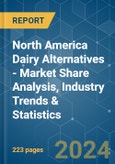Online retail channels are partnering with many brands to boost their sales
- The distribution channel of the North American dairy alternatives market is segmented into on-trade and off-trade. The off-trade channel plays a major role in the sales of alternative dairy products in the region. Supermarkets and hypermarkets are the largest off-trade distribution channels in the North American dairy alternatives market. The proximity factor of these channels, especially in large and developed cities, provides them with an added advantage of influencing the consumers' purchasing decisions. In 2022, the sales value of dairy alternatives through supermarkets and hypermarkets accounted for more than 73.4% compared to other retail channels.
- Plant-based milk plays a major role in the overall sales of retail channels. In 2021, the sales value of plant-based milk increased by 8.5% compared to 2020, while animal-based milk sales declined by 2%. In the same year, 42% of households purchased plant-based milk, and 76% bought it multiple times from retail channels.
- The online channel in North America is projected to be the fastest-growing distribution channel for dairy alternatives. It is anticipated to grow by 44% in 2024 compared to 2021. Online retailers are partnering with brands to expand their shelf space, increase assortments, and improve consumers’ shopping experience by offering a wide range of plant-based products. As of 2021, more than 22% of Canadians preferred to buy groceries online.
Explosive population consumption and government backing is fueling the market growth
- The North American dairy alternatives market dominates the global market due to the increasing lactose intolerance and adoption of healthy diets. As of 2022, 30-50 million Americans were found to be lactose intolerant. The most preferred dairy-free products are milk, butter, frozen desserts, and cheese.
- The United States is the leading market for dairy alternatives in the region. It is projected to register the fastest Y-o-Y growth rate of 26% by value during 2024-2027. The higher demand is due to the higher production volume of nuts (almonds) and soybeans. For example, the United States produces around 2,002,742 metric tons of almonds annually, accounting for 80% of the world’s almond production. Continuous product launches are the key factor promoting the sales of dairy alternatives in the country, as American consumers are highly open to trying new products.
- As of 2021, 62% or 79 million US households bought plant-based products, an increase from 61% or 77 million in 2020.
- Canada is the second-leading market for dairy alternatives. Government support is the primary factor boosting the sales of non-dairy products in the country. In 2018, the government included the dairy alternatives industry in its Supercluster Initiative and invested USD 150 million in its development. In 2021, it invested an additional USD 173 million.
- The sales of dairy alternatives are expected to grow due to an anticipated increase in lifestyle disorders and lactose intolerance. The North American dairy alternatives market is projected to grow by a value of 16% in 2025 compared to 2023.
North America Dairy Alternatives Market Trends
Increasing vegan and flexitarian populations driving the consumption of dairy alternatives in North America
- The per capita consumption is increasing at a considerable rate in the United States, resulting in both investments and innovations. It registered a growth of 5.56% in 2022 from 2021, primarily due to the rise in consumers following a vegan diet. There is a section of consumers that prefer dairy alternatives because of environmental concerns and associated health benefits. The majority of the US population is consuming lesser dairy and other dairy by-products instead of eliminating them. They also tend to be more flexitarian than vegan. Nearly 12% of consumers in the United States preferred a plant-based diet, whereas 7% of consumers followed a flexitarian diet as of 2022.
- There is a constant rise in the per capita consumption of oat, soybeans, pea, and almonds due to their wide applications in different food products like plant-based meat products, confectionery, bakeries, and beverages. In 2020, retail sales of milk alternative beverages were valued at USD 336.9 million in Canada and USD 2.8 billion in the United States. The prevalence of allergies to animal products and by-products, like cow's milk and eggs, is among the reasons that have prompted consumers to switch to dairy alternatives. As of 2022, nearly 59% of the Canadian population and 48% of Mexicans were lactose intolerant. As a result of the current vegetarian or vegan trends, which are primarily popular among young people, 20% of Mexican consumers have "reduced or eliminated the consumption of dairy or foods produced from animals." Previously there were only two categories, i.e., vegetarian and non-vegetarian.
North America Dairy Alternatives Industry Overview
The North America Dairy Alternatives Market is fragmented, with the top five companies occupying 26.56%. The major players in this market are Agrifoods International Cooperative Ltd, Blue Diamond Growers, Califia Farms LLC, Danone SA and Oatly Group AB (sorted alphabetically).Additional Benefits:
- The market estimate (ME) sheet in Excel format
- 3 months of analyst support
Table of Contents
Companies Mentioned (Partial List)
A selection of companies mentioned in this report includes, but is not limited to:
- Agrifoods International Cooperative Ltd
- Blue Diamond Growers
- Califia Farms LLC
- Campbell Soup Company
- Danone SA
- Eden Foods Inc.
- Kite Hill
- Land O'Lakes Inc.
- Miyoko's Creamery
- Oatly Group AB
- Otsuka Holdings Co. Ltd
- SunOpta Inc.
- The J.M. Smucker Company
Methodology

LOADING...








